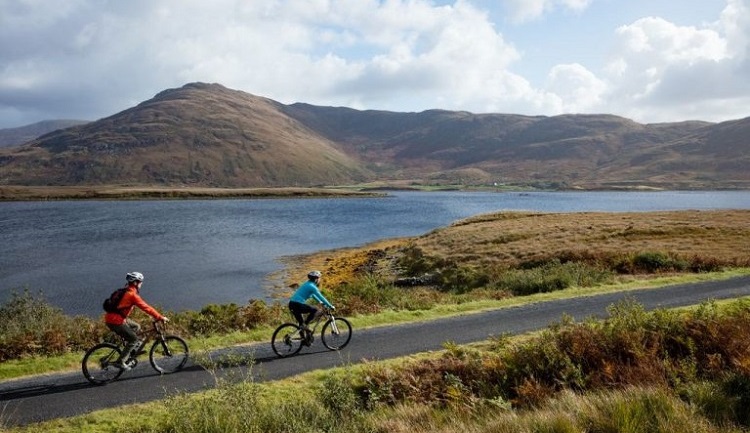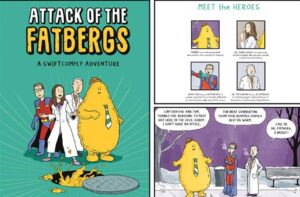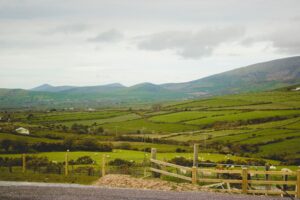Ireland’s relationship to land and landscape, the neoliberal approach to development, and the future of rural Ireland with Dr. Karen Keaveney, School of Agriculture and Food Science.

Karen Keaveney
Assistant Professor
UCD School of Agriculture and Food Science
UCD Profile
Q: You write a lot about rural Ireland. Do we in Ireland tend towards a utilitarian, economic understanding of the rural, perhaps forgetting some other positive aspects, like recreation and biodiversity?
A: The tension that happens in Ireland is centred around land or landscape. We’ve got this idea that a choice has to be made between the two: that it must be functioning, productive land, and that the idea of landscape then is seen as a luxury.
One positive thing about our relationship with the rural in Ireland is that we have loads of public roads; we actually have very high accessibility to the countryside. Our land ownership is largely family farm structured, tending towards smaller farms and highly fragmented farms. We have great potential to open up the countryside. The Department of Rural and Community Development have rural recreation funding available to create walkways. During COVID, in Longford, they have gone into negotiation with landowners who own land up to the lakes, to allow people to access the lakes. I think innovations are happening in terms of access.
On the other side, one of the reasons in Ireland we have such a productivist approach to agriculture is the farm lobby. The Irish Farmers Association is incredibly strong, hence you’ll see farming featuring as the main sector in all policies for rural Ireland including the Programme for Government. But it isdebatable whether farming should be at the centre of all rural territorial strategies, because the majority of people living in rural Ireland are not working in farming.
I would see the rural as providing a lot of the answers for climate change if we start thinking about how we can farm differently and how we use the countryside differently. It’s about sustainable agriculture and how that fit with a biodiversity outlook.
Q: Has COVID changed how people are using the countryside?
A: You can definitely see a difference in terms of how we’re using the countryside; everyone is cycling, people are walking everywhere. When silage season started, normally the warnings are for people to beware of tractors but it has been the other way around. That is something that should be built on. For instance, walkability; from studies I’ve been involved in at Queen’s, walkability is often not great in the countryside. It can be quite unsafe in terms of lighting. But I think a lot of things could come out of this period, which we can learn from. Seeing people using the country roads for walking, using the natural amenities, if that becomes the norm, it becomes embedded.

“One positive thing about our relationship with the rural in Ireland is that we have loads of public roads; we actually have very high accessibility to the countryside. Our land ownership is largely family farm structured, tending towards smaller farms and highly fragmented farms. We have great potential to open up the countryside.”
– Dr Karen Keaveney
Q: Do you see any slowing down of the urbanisation trend in Ireland, or is there still a big draw towards Dublin?
We have only really been an urban society since the 1960’s, when our industrial society arose. We’re at least 100, if not 200, years behind most of Europe. We’re not a terribly urban country. You can see that in politics, how strongly the rural is placed. For me, there’s a physical manifestation of urbanisation but it’s a process as well. It’s about economy and society. Rural and urban: one can’t live without the other, it’s on a continuum.
The issue with Dublin is about regional development and the lack of balanced regional development. I think it’s positive to have a strong capital city. The problem I have is that planning is one of those disciplines where there’s a perceived urban-rural tension. But the reality is planning has been really weak in Ireland. Both the rural and urban are damaged by the planning system. We’re not using planning as the positive tool it can be to facilitate development, in a sustainable way. I’m a rural geographer and rural planner but I engage with the urban literature and my urban colleagues. I can’t separate the urban and the rural as the same processes are happening in both.
Q: In terms of planning and development policy, some argue that the rural is maligned where others say there’s an anti-urban bias in Irish politics. What do you think?
A: There isn’t an anti-Dublin bias in Irish policy. We have a neoliberal approach to development, that is the problem, and it affects urban, rural, and everything in between. If we start pitting rural against urban, we are only hurting ourselves. The neoliberal model has had such a detrimental effect on housing. Privatisation and financialisation of public good has had such a detrimental effect on all aspects of our lives. There may be a feeling or sense that the rural is dominating politics and policy – because we’ve had coalition governments and they’ve had to rely on the independents, the rural issues seem to come to the fore, but those issues are not substantially being matched up by funding. Positively, there is a Department of Rural and Community Development (now under Social Protection), which also looks after community development, so most of its funding mechanisms are a mix of urban and rural, and much of the funding and investment goes into urban areas.
From before the Celtic Tiger to now, politics has expected public good to be addressed by market forces. For instance, there’s a housing crisis in rural Ireland as much as in urban. What can happen in rural Ireland is some of the issues are more hidden. We have hidden poverty. Possibly someone does own a house, but it’s an inherited house that’s falling apart. There’s hidden homelessness. There is an idyllisation of the rural in western Europe, because it looks pretty, therefore everything must be okay. That’s not always true.
“People say, ‘down the country, oh community is great, aren’t we great at funerals’. But there are really strong communities, both in rural and urban settings. People often act as if community only exists in a positive way in the rural. That’s not true. People are people.”
– Dr Karen Keaveney
Q: Are there many other misperceptions about differences between urban and rural life?
A: Most rural researchers have lived in both rural and urban, so have personal experiences of both. Living rurally is just as complex as living in a city. On the other hand, a personal bugbear of mine is when rural politicians talk about rural community and how special it is. I lived in urban settings for twenty years and community was amazing there too. People say, ‘down the country, oh community is great, aren’t we great at funerals’. But there are really strong communities, both in rural and urban settings. People often act as if community only exists in a positive way in the rural. That’s not true. People are people. In one way, COVID has highlighted that community is strong, both rural and urban.
I think there’s also, in a sense, an existential acceptance of complexity in an urban setting, and an assumption that rural areas are not. When the national spatial strategy was adopted in 2002, loads of research went into that, and they mapped rural areas and created typologies. They really looked at diversity, but since then, we’ve had the National Planning Framework and various processes, and we haven’t delved in deep. We need evidence-based decision making. If we’re not getting to the evidence, how can we make the right decisions?
Q: There is a perception of rural decline on a mass scale in Ireland, do you think that’s true?
A: I would see this decline narrative as really dominating the politics of rural Ireland. It can be a bit ‘woe is me, the towns are dying’. I’m living in it and researching it, and yes, there are problems and challenges, but there are positives happening as well. I know there are vacancy issues in rural towns, as there are in cities as well. I am in no way saying there aren’t problems in rural areas. There are problems with sustainable livelihoods, the kinds of jobs people can get, young people leaving and being unable to return. It’s the lack of complexity that’s applied that I have an issue with, we need to get down into the data. We have really good data, we can map evidence. In some places there is population decline, but other places it’s growing. I’m finding that people are being drawn to towns as a centre point – that is a major change in patterns in more recent years.
The decline narrative is easy to focus on, because the politicians can say, this is our issue. The problem is it tars all rural areas with the one brush. It’s not saying there are different rurals, types of rural areas. Offaly is different to Kerry; there is going to be a different tourism draw around Killarney, and Tullamore isn’t going to get all the tourists. Therefore, you have to say what is a place good at? What is there?
Q: What does the future hold for rural Ireland?
It’s about having a mix. It’s the philosophy of rural development, you take a place-based approach – what are we good at? That includes human capital and resources, the physical infrastructure. What can we do? It goes down to that local level. The only way we can support rural development is from the bottom up. If you don’t have any natural tourism attractions, why would you do tourism? Tulsk in Roscommon is a good example. It’s a very small village that you drive through on the Dublin-Castlebar N5 route, it’s going to be bypassed. Tulsk is one of the key archaeological sites in Ireland. Its old name is Rathcroghan, and it has the largest amount of Raths in the country. They are investing in that, there is a small visitor centre. They’re going to have cycle paths from the visitor’s centre to the ringforts. They decided to take the bypass as a positive.

Rath near Tulsk, County Roscommon
Q: Can there be an overreliance on tourism as a panacea for rural development?
A: There has been in ways, but I think people overall are realistic. That’s my sense from working in rural development. It’s about scale and recognising the level of tourism and recreation appropriate for where you are. Killarney is a global tourism destination, but tourism can also be local walks and cyclepaths. It’s about scale and promotion. One positive that will come of COVID is the staycation. If people are looking for things close by, you can’t travel but you still want things to do, then promote at the local level. Usually, it’s about the local stuff. It’s about diversity and catering to the local community as well as other tourists. Foreign Direct Investment is not the answer to rural development, nor is remote working. This whole situation has meant that people are more open to remote working, which is great. But it’s not the silver bullet. A lot of remote working jobs are quite low paid. We don’t want to become another back office. It has to be mixed, and we need to provide choice for people. In general, it’s about diversity. You can’t rely on one sector and you need an openness to change.
Q: Are there opportunities for rural communities in the turn towards environmental considerations, sustainable agriculture, the cessation of peat extraction?
A: We can’t see this, the negative, that ‘they’re trying to stop us’. It is about climate justice. It’s not just about greening, it’s about how we provide better for society, how we support society through the green agenda. COVID brings up issues to do with farming. We do have a good record on animal welfare, but are we relying on a diet that’s not very good for us and not good for the planet? I’m not saying we all have to be vegan, but it’s about variety; can we do things a bit different here? There are also cultural elements – there are huge pressures on family farms concerning succession. That obligation and a sense of needing to continue family traditions. In other studies with colleagues, we’re seeing that sense of obligation is declining, you can’t raise a family on a farm. We are seeing necessity-driven innovation. It’s helped by schemes like GLAS (the agri-environment scheme under the Rural Development Programme 2014 – 2020) and incentivising biodiversity. However, most farms are not financially viable in Ireland. The model is broken, people aren’t getting enough for their produce. Maybe that’s where some of that urban-rural tension comes in; people are saying ‘why are farmers getting subsidies?’ Well it’s so you can buy cheap food. There’s something broken there.



